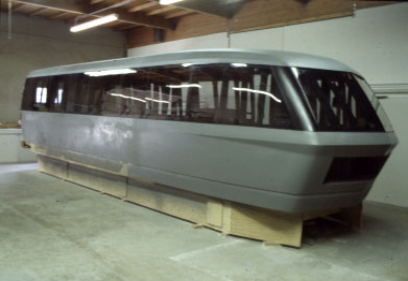Ground Level Transit
What is ground level transit?

Ground level transit technology is an advanced transit industry term for trains, streetcars, and basically every modern type of transport dedicated to carrying passengers as its primary cargo. Ground level means that a transit system has fixed rails or maglev (magnetic levitation) guideway, imbedded in the ground. Elevated means the fixed rail tracks are raised above ground. Subterranean is partially underground, tunneled is underground. For common-sense safety, transit is grade separate; meaning that there is no pedestrian or other vehicle interaction with the track rights-of-ways.
Available technology
Is there available technology to implement sustainable ground level transit systems?
For 20 years, the most authoritative compilation of new technology transit innovations was a published list from Jerry Schneider. It included every serious innovative transportation technology. The site: https://faculty.washington.edu/jbs/itrans/PRT/ discontinued its continual upgrade of new technology transit innovations around 2015. It’s always a pleasant surprise to see that the website is still operational, even though it’s been several years since it’s been maintained. The site still has the most complete list of proposed innovative ideas for transit.
The current leading organization maintaining advocacy of advanced transit technology is ATRA, Advanced Transit Association. Their list of technology systems in public use and development, describe 21 systems. Most of these systems are appropriate to serve as parking lot shuttles. These systems share similar designs to amusement park shuttles and ski lift operations.
Transit systems and urban design
Transit systems must comply to urban design. Any transit system unable to meet all of society’s transportation demands for its urban design; these transit systems serve like a band-aid to heal a broken leg. Very few of these transit technologies in development, nor government funded systems being implemented are viable transportation solutions. Many of the transit system technologies will never become useful alternatives to anything except being good parking lot circulators.
Western society uses an automobile centric land-use design
The primary component to serve as a viable transportation replacement solution for automobiles has to be as convenient, or more convenient than a car. This requires a 24/7 door to door service capability to an entire urban area. Cars also have a personal socioeconomic value that is a challenge to transit. The other pieces needed to surpass what a car offers are: economic factors, energy efficiency, safety, and lastly the environmental impacts.
Additionally, any viable transportation solution has to be much faster than a car. An average car has the ability to travel over 100 mph and comfortably carry four passengers. A transportation system capable of very fast speeds, has merit as a transportation solution. To be viable, this very fast speed has to exceed the aeronautic capabilities over long distances.
Viable long-distance transit
ET3 is the only transportation technology system in development capable of reaching this fast speed. As a long-distance transit solution, it isn’t listed on the ATRA site. ET3 has a computer simulated speed of Mach 6 (4,500 mph). Its projected cost is less than 1/10th of any other mass transit technology, even though its speed is many times faster than any other US transit technology.
Another entire industry movement in the advanced transit technology industry is Hyperloop. The combined capital investment into Hyperloop is hundreds of millions of dollars towards development.
One of today’s leading marketing geniuses is Elon Musk. He recognized open opportunities in transportation many years ago. His keen insight found that the entirety of transportation relies on its infrastructure. His Boring Company is poised to be in a very advantageous position when society realizes that cars are unsustainable.
Public transit
Are there advantages to transit? There are several considerations to mention. First, all urban growth is based on its primary source for transportation. This means that the available public transit system has to comply to the land-use design. To meet the entirety of area’s transportation demands, a transportation solution has to be able to accommodate all the transportation scenarios. How does a carpenter carry his tools to work? How does uber eats deliver food? How do people go to the store and get five or ten bags of groceries? How does someone take their injured pet to the vet in an emergency? How do kids get to school? There are literally thousands of varying transportation scenarios. A transportation solution must comply in a superior manner than an automobile: in an automobile centric land-use design.
Western Society uses the automobile centric land-use design. Since the automobile is the primary source of its transportation, a transportation solution has to be able to replace the transportation requirements of an automobile.
Transit systems
Is it a good idea to put money and effort into transit systems which are effectively band-aids? Most transit projects are built by the government. Government projects are built with a different perspective than private industry. All government projects are built on principles of procedure. Good ideas, practicality, and precautionary actions are irrelevant. To the question: is it a good idea to put money into ineffective, antiquated, or inadequate technology; practicality is an irrelevant component to government funded transportation projects.
With this said, why are private companies un-participatory in public transit? Its operation is unprofitable. Car manufacturers would be out of business if they had to pay for the infrastructure their products operate on. It’s part of the automobile being unsustainable: the government subsidizes that industry’s infrastructure. The burden of infrastructure costs are place onto the consumer and tax payers.
Maglev
There is an article on the CATTCC information page about Maglev Technology. Transit systems with maglev technology actually provide mobility solutions and environmental sustainability. It’s found by efficient energy use and the lack of mechanical resistance.
Advanced transit systems with nontrain maglev technology are far superior in efficiency to any other transit. The computer operated advances in nontrain maglev transit systems offer the flexibility of smaller vehicles to provide higher mobility in service capabilities, direct to destination service, lighter vehicles, short headways for higher car count and much greater passenger per hour load capacities. This new technology transit is tremendously less expensive for infrastructure buildout.
Comparing automobiles with maglev technology; an automobile requires a 3,000-pound vehicle to carry a single 200-pound load. The efficiency of nontrain maglev technology is its ability to have lightweight vehicles weighing 500 pounds. Without contact to the ground, however, it remains virtually weightless and maintains frictionless efficiency. With maglev, a 500-pound load can be propelled by a one-quarter horse electric motor (Lev-X). In cars, resistance caused by friction of moving parts causes massive inefficiencies. There are no moving parts on a passive maglev transit system: the load carrying vehicles are levitated by the magnetic force of the passive guideway, and are therefore not attached as moving parts.
Maglev transit technology exercises efficient energy design and is sustainable transportation. The most efficient form of transportation is found within passive magnetic guideways, which encompass a different technological approach than the methodology used to electrify the guideways with electromagnetism. Electrified guideway technology seen in the commercialized maglev transit systems throughout China more complicated, and more costly. The cost of building nonelectrified guideway infrastructure for smaller, lightweight vehicles is substantially less expensive; nontrain direct-to-destination technology is more efficient as an urban transportation system.
Maglev systems can be designed to encompass global travel. With no resistance and encapsulated within an air evacuated tube, there is further reduction of air resistance. One such maglev system in development is ET3. It has been computer simulated to travel at a speed of Mach 6 with an efficiency rate incomparable to any other form of transportation system.
The explanation for high efficiency in new technology transit systems is found in the agility of vehicle size; smaller vehicles that weigh less require less intensive infrastructure. Another ingredient of nontrain new technology transit technology is the interactive computerization of automatic track, or guideway switching, which lowers system maintenance and increases overall system efficiency with bypassing unwarranted station stops.
The primary cause to support the smaller vehicle size of advanced transit technology systems is the impracticality to believe all passengers on a train in our modern society would have the same destination. From the perspective of a train passenger in the 2000s, why should any single rider be inconvenienced to constantly waste their time for every other passenger to board and exit along the route? And then to be taken somewhere other than the door of their destination and obligated to obtain other means of transportation to arrive at their destination? Trains provided a marvelous service for society’s transportation needs when train systems began delivering passengers in the 1800s. In the early 1900s, buses provided lower initial operating costs by using citizen-paid tax road funds, eliminating infrastructure as an operational expense; and yet buses are still not able to offer the convenience of independent travel needs.
The topic of ground level transit is incredibly complex.



